Welcome to Lean Marketing
What has changed in marketing over the past five years? It seems, literally everything: the struggle for conversion has tightened, the rates in the context are growing, the situation in the channels of attraction is constantly changing, the tools for the marketer are complex and there are a lot of them, the customer is demanding, changes the Wishlist and are always there. As a result, the timing and results are increasingly unpredictable. Simply put, we look at the picture and agree:
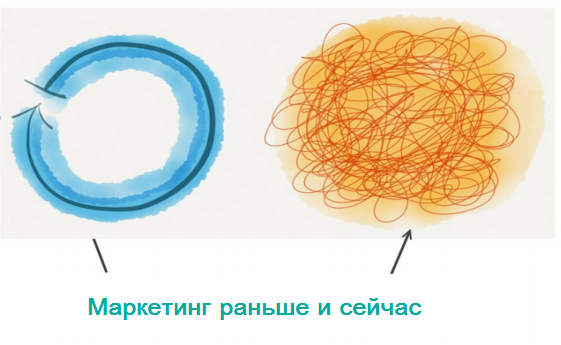
How to build a process for a team of marketers when external working conditions are so unpredictable and change so often? What new process management methodologies to use?
To answer this question, you need to remember what other processes in IT companies have become so complicated that they required the introduction of new methodologies? The first thing that comes to mind is development. Previously, waterflow was enough, and now apply Scrum, Kanban, XP, etc.
')
Referring to the Kenevin model (Cynefin framework), to clarify the situation. Judging by the model, any processes can be divided into Simple, Complex, Confusing, Chaotic, and all this is visualized as follows:
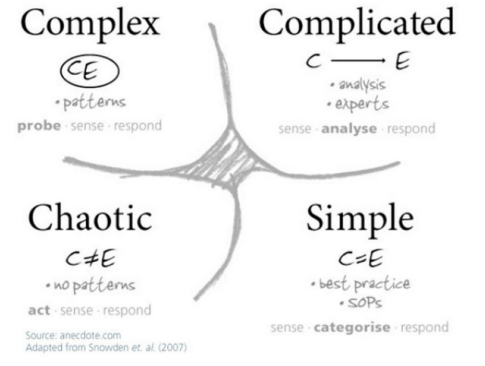
It is considered that the left upper zone (Complex) is the Agile zone. The increasing complexity of programming, such as changing customer requirements, the uniqueness of each solution, increasing risks and costs, is a consequence of weak links between the customer, performer and consumers, which flexible methodologies try to solve through short iterations, retrospective, etc.
The second example is business. There was a time when a business opened up for a carbon copy, according to a business plan. The slogan of the zero: “Do something qualitatively and the market will eat it”. But competition is growing, all niches are occupied, in order to pierce the market, we must look for something fundamentally new. To literally get out of the chaos of ideas (left lower zone) a new tangled business model and, through the search for repetitive practices (left upper zone), make a day-to-day business (upper right zone).
Creating a business and even maintaining an existing one is very difficult. As in Alice through the looking-glass: “... you have to run as fast as you can just stay in the same place.” Business has moved from the process of Complicated to Confusing, as a result, the principles, methodology, authorities, textbooks have changed, there is a need for new institutions (incubators, accelerators).
Similar processes, but with a slight delay, occur with marketing, and in the first place, with Internet marketing. Too many changing external factors in marketing force to completely change the internal marketing processes.
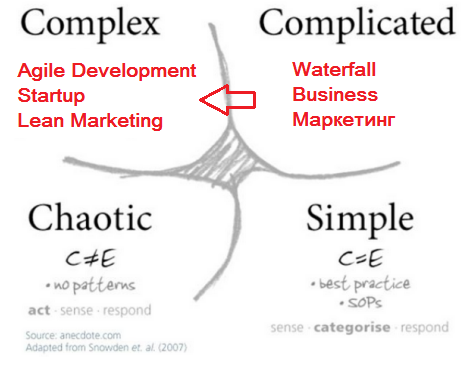
What is it inside the confused zone? What are the principles?
Reminds book Lean Startup from Eric Rees? Experiments, hypotheses, the search for repetitive practices. Lean Startup is the source of inspiration for Lean Marketing, but first things first.
In 2010, the book “Marketing Based on Data ...” by Mark Jeffrey was published, in which the author strongly recommends putting data on customer behavior at the center of everything and using 15 key marketing indicators to measure and improve the effectiveness of marketing activities. Also, Mark tells what difficulties marketers face in analyzing data. The main message of the book:
2011. Eric Rees, in The Lean Startup: ..., offers a completely new concept of bringing products and services to the market. If we discard the motivational theses that the entrepreneur lives in each of us, then the Lean Sturtup concept has made this book outstanding.
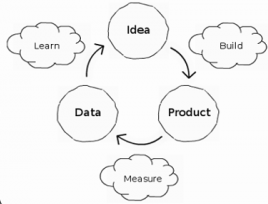
In 2012, they first formulated the principles of agile marketing at the SprintZero: The Physics of Agile Marketing summit and called it Agile Marketing Manifesto (again, by analogy, Manifesto for Agile Software Development manifesto).
2012-2014. A series of books from different authors, but with proofreading by Eric Ries. This is often a very successful attempt to apply the principle of “create-evaluate-learn” (Build, Measure, Learn) for the lean development of the client, user interface, corporations and even the brand.
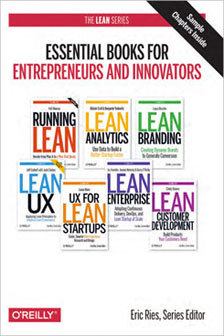
So, on the one hand, marketing is becoming more complex with each passing day, and with the help of old management textbooks, one can no longer unravel the tangled tangle of marketing tasks. On the other hand, the processes in startups are very similar and there is a new understanding of how to act based on flexible methodologies.
As a result, we see the birth of new marketing - Lean Marketing based on Eric Start's Lean Startup. I will try to give a definition as close as possible to the concept of Lean Startup:
How do you? Vote for this definition or give your option link in the comments. Let's decide what awaits us ahead)
How to implement Lean Marketing in the company, I will tell in the following posts.

How to build a process for a team of marketers when external working conditions are so unpredictable and change so often? What new process management methodologies to use?
To answer this question, you need to remember what other processes in IT companies have become so complicated that they required the introduction of new methodologies? The first thing that comes to mind is development. Previously, waterflow was enough, and now apply Scrum, Kanban, XP, etc.
')
Referring to the Kenevin model (Cynefin framework), to clarify the situation. Judging by the model, any processes can be divided into Simple, Complex, Confusing, Chaotic, and all this is visualized as follows:

Simple (Simple) - the relationship in these systems is obvious to any reasonable person, the causal relationships in these systems are also clear and are on the surface.
Complicated - there are causal relationships, but not so obvious and difficult to understand for non-experts.
Tangled (Complex) - causal relationships can not be detected in advance, even with a serious analysis. They will become clear only after the event occurs and it is possible to build a Retrospective.
Chaos (Chaotic) - no causation. Nothing is clear. It is impossible to draw any conclusions. Chaos is a temporary condition. Complete chaos in nature exists for a very short time and only as a kind of transition state.
It is considered that the left upper zone (Complex) is the Agile zone. The increasing complexity of programming, such as changing customer requirements, the uniqueness of each solution, increasing risks and costs, is a consequence of weak links between the customer, performer and consumers, which flexible methodologies try to solve through short iterations, retrospective, etc.
The second example is business. There was a time when a business opened up for a carbon copy, according to a business plan. The slogan of the zero: “Do something qualitatively and the market will eat it”. But competition is growing, all niches are occupied, in order to pierce the market, we must look for something fundamentally new. To literally get out of the chaos of ideas (left lower zone) a new tangled business model and, through the search for repetitive practices (left upper zone), make a day-to-day business (upper right zone).
Creating a business and even maintaining an existing one is very difficult. As in Alice through the looking-glass: “... you have to run as fast as you can just stay in the same place.” Business has moved from the process of Complicated to Confusing, as a result, the principles, methodology, authorities, textbooks have changed, there is a need for new institutions (incubators, accelerators).
Similar processes, but with a slight delay, occur with marketing, and in the first place, with Internet marketing. Too many changing external factors in marketing force to completely change the internal marketing processes.

What is it inside the confused zone? What are the principles?
In intricate systems, we begin to build hypotheses and create all sorts of experiments to confirm or dispel these hypotheses. For each sane point of view or theory that has arisen, we create an experiment or a series of experiments. These experiments do not necessarily have to be crowned with success, but must provide insight and add insight into what is happening. Experiments can run in parallel and contradict each other.
There is no best or good practice in this area. Practices here arise as experiments are conducted.
Reminds book Lean Startup from Eric Rees? Experiments, hypotheses, the search for repetitive practices. Lean Startup is the source of inspiration for Lean Marketing, but first things first.
History Lean Marketing
In 2010, the book “Marketing Based on Data ...” by Mark Jeffrey was published, in which the author strongly recommends putting data on customer behavior at the center of everything and using 15 key marketing indicators to measure and improve the effectiveness of marketing activities. Also, Mark tells what difficulties marketers face in analyzing data. The main message of the book:
“80% of companies do not use data-based marketing. The remaining 20% become leaders "- Mark JeffreyIt is this book that created Data-Driven Marketing. I will try to give the following wording DDM:
Data-Driven Marketing is a type of marketing where ALL marketing decisions and actions are based on data about users and their behavior.
2011. Eric Rees, in The Lean Startup: ..., offers a completely new concept of bringing products and services to the market. If we discard the motivational theses that the entrepreneur lives in each of us, then the Lean Sturtup concept has made this book outstanding.

Lean Startup - the concept of an iterative approach to the development and launch of new products on the market, while constantly eliminating all types of losses and maximizing value for the consumer, until resources run out.By the way, the cycle “create-evaluate-learn” (Build, Measure, Learn) is an analogue of the sprint in the flexible programming methodology of Scrum.
In 2012, they first formulated the principles of agile marketing at the SprintZero: The Physics of Agile Marketing summit and called it Agile Marketing Manifesto (again, by analogy, Manifesto for Agile Software Development manifesto).
Manifesto Agile Marketing
Training instead of opinions and conventions.
Customer-oriented cooperation instead of hierarchy.
Adaptive and iterative campaigns instead of voluminous and complex.
Opening customers instead of static prediction.
Flexible planning instead of hard.
Reactions to changes instead of following the plan.
Many small experiments instead of one big one.
2012-2014. A series of books from different authors, but with proofreading by Eric Ries. This is often a very successful attempt to apply the principle of “create-evaluate-learn” (Build, Measure, Learn) for the lean development of the client, user interface, corporations and even the brand.

- Running Lean By Ash Maurya January 2012 Running Lean in Russian
- Lean UX By Jeff Gothelf February 2013
- Lean Analytics By Alistair Croll, Benjamin Yoskovitz March 2013
- UX for Lean Startups By Laura Klein May 2013
- Lean UX Workshop By Jeff Gothelf April 2014
- Lean Customer Development By Cindy Alvarez May 2014
- Lean Branding By Laura Busche September 2014
- Lean Enterprise By Jez Humble, Barry O'Reilly, Joanne Molesky December 2014
Conclusion
So, on the one hand, marketing is becoming more complex with each passing day, and with the help of old management textbooks, one can no longer unravel the tangled tangle of marketing tasks. On the other hand, the processes in startups are very similar and there is a new understanding of how to act based on flexible methodologies.
As a result, we see the birth of new marketing - Lean Marketing based on Eric Start's Lean Startup. I will try to give a definition as close as possible to the concept of Lean Startup:
Lean Marketing is a type of marketing in which a constant process of eliminating all types of losses and maximizing customer value using the iterative “create-evaluate-learn” approach and constant communication with the client is launched.
How do you? Vote for this definition or give your option link in the comments. Let's decide what awaits us ahead)
How to implement Lean Marketing in the company, I will tell in the following posts.
Source: https://habr.com/ru/post/295934/
All Articles